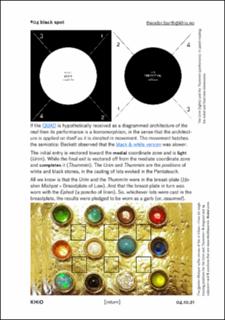black spot #01-06
| dc.contributor.author | Barth, Theodor | |
| dc.contributor.editor | Barth, Theodor | |
| dc.coverage.spatial | Norway, Oslo | en_US |
| dc.date.accessioned | 2021-10-08T05:51:12Z | |
| dc.date.available | 2021-10-08T05:51:12Z | |
| dc.date.issued | 2021-10-08 | |
| dc.identifier.uri | https://hdl.handle.net/11250/2788552 | |
| dc.description | Flyer set of 6 (1HEX): #01—attempt; #02—try again; #03—do something else; #04—return; #05—unlearn; #06—crossover. | en_US |
| dc.description.abstract | The flyer series draws up an often neglected discussion on late mediaeval/renaissance backdrop of modernism: whether referring to the Bauhaus, Samuel Beckett, Marcel Duchamp or Le Corbusier. The series are panels developed in the wake of discussions related to this topic, with PhD fellow Bjørn Blikstad (furniture). They are prompted by his work, Georges Didi-Huberman’s project of visual anthropology and a perceived need to deconstruct C.G. Jung. It is not possible to selve into the visual anthropology involving the crafts without passing through the alchemical heritage of emblems. Given that a turn to the crafts will determine a vantage point on what art does (as revealed in what it shows). In this realm desire/libido and metaphysics—the gut and the stars—are entangled. Finding a method to deal with the tangle (their superposition and intra-action rather than separation) is a worthy challenge for contemporary artistic research. Do we find anthropology in the repertoire of an expanded art history? Or, a related question, will the expanded field of performance—or, performativity—prove mediations in subject matters, and areas, that we walk around? The black spots on the “map”. Images as panels, readable as an atlas. Reading what was never written. Performance. | en_US |
| dc.language.iso | eng | en_US |
| dc.publisher | KHiO | en_US |
| dc.relation.haspart | 6 Flyers | en_US |
| dc.rights | Attribution-NoDerivatives 4.0 Internasjonal | * |
| dc.rights.uri | http://creativecommons.org/licenses/by-nd/4.0/deed.no | * |
| dc.subject | black spot | en_US |
| dc.subject | white spot | en_US |
| dc.subject | atlas | en_US |
| dc.subject | panel | en_US |
| dc.subject | hermetism | en_US |
| dc.subject | sidereal | en_US |
| dc.subject | visceral | en_US |
| dc.subject | readability | en_US |
| dc.subject | QUAD | en_US |
| dc.subject | Beckett | en_US |
| dc.subject | Plato | en_US |
| dc.subject | Republic | en_US |
| dc.subject | Bruno Latour | en_US |
| dc.subject | Mikhail Bakhtine | en_US |
| dc.subject | Marc Augé | en_US |
| dc.subject | non-places | en_US |
| dc.subject | initial | en_US |
| dc.subject | final | en_US |
| dc.subject | ritual | en_US |
| dc.subject | mediation | en_US |
| dc.subject | semiotics | en_US |
| dc.subject | vectorial sum | en_US |
| dc.subject | semiotics | en_US |
| dc.subject | agent intellect | en_US |
| dc.subject | Aristotle | en_US |
| dc.subject | Bjørn Blikstad | en_US |
| dc.subject | Aby Warburg | en_US |
| dc.subject | Peacock cabinet | en_US |
| dc.subject | Taweret | en_US |
| dc.subject | Edmund Leach | en_US |
| dc.subject | architecture of the real | en_US |
| dc.subject | Urim and Thummim | en_US |
| dc.subject | Hoshen Mishpat | en_US |
| dc.subject | Ephod | en_US |
| dc.subject | Pentateuch | en_US |
| dc.subject | Doxosophes | en_US |
| dc.subject | bogus | en_US |
| dc.subject | Nachmanides | en_US |
| dc.subject | Bourdieu | en_US |
| dc.subject | Art-history | en_US |
| dc.subject | Aufstellung | en_US |
| dc.subject | Lineup | en_US |
| dc.subject | timescape | en_US |
| dc.subject | book | en_US |
| dc.subject | library | en_US |
| dc.subject | archive | en_US |
| dc.subject | Colours | en_US |
| dc.subject | Genetic epistemology | en_US |
| dc.title | black spot #01-06 | en_US |
| dc.type | Design | en_US |
| dc.description.version | draft | en_US |
| dc.rights.holder | Theodor Barth | en_US |
| dc.subject.nsi | Anthroponomy | en_US |
| dc.relation.project | Project Spinoza | en_US |
Tilhørende fil(er)
Denne innførselen finnes i følgende samling(er)
-
Barth, Theodor [103]
Kunstneriske resultater og prosjekter







